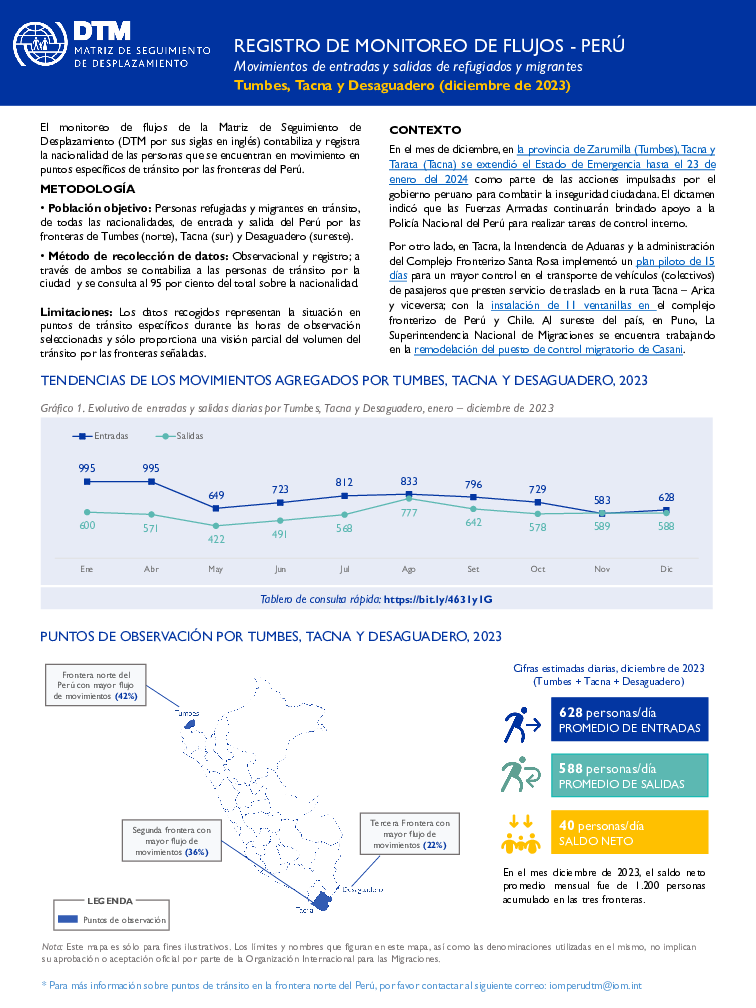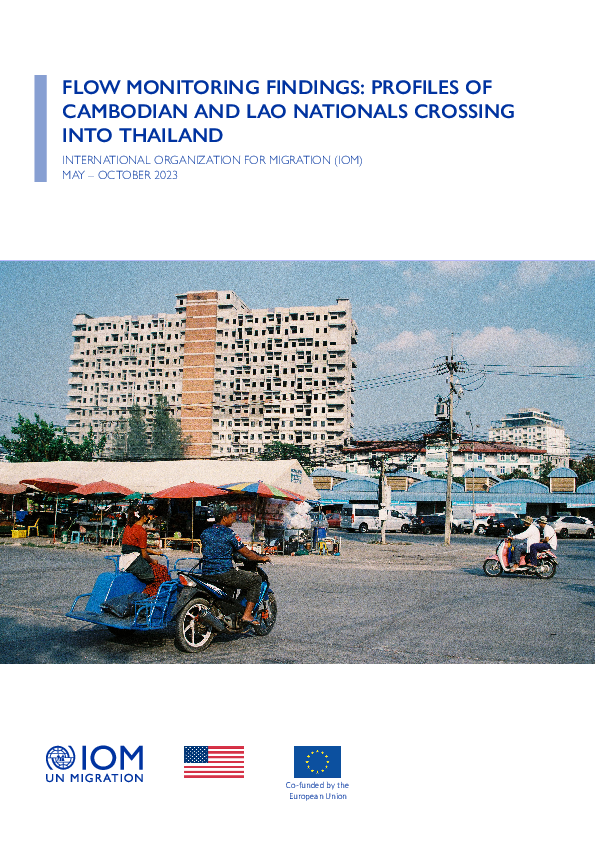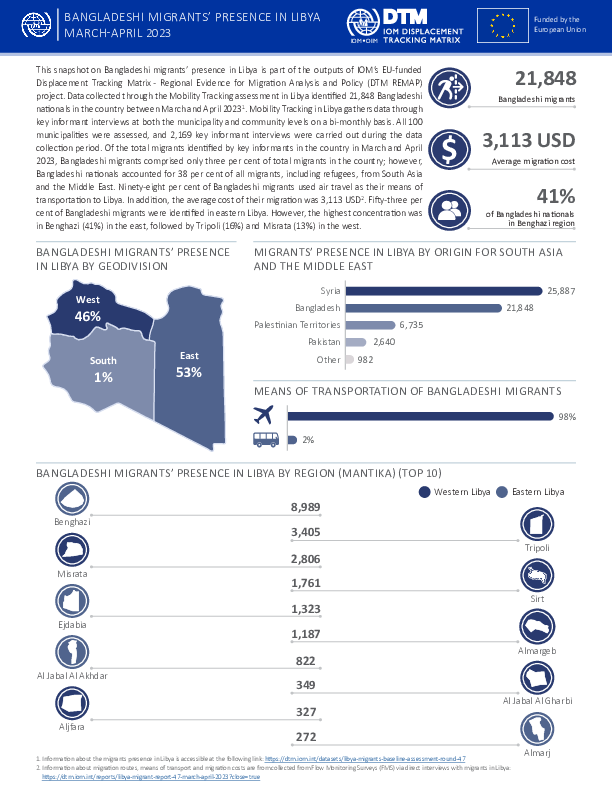-
Countries
-
Data and Analysis
-
Special Focus
-
Crisis Responses
Flow Monitoring
Domain host
migration.iom.int

Contact
iombuenosaires@iom.int
Language
Spanish
Location
Argentina
Period Covered
Jun 01 2023
Nov 30 2023
Activity
- Survey
- Flow Monitoring Survey
En diciembre de 2023 se estima que aproximadamente 7,7 millones de personas de nacionalidad venezolana residen fuera de su país, de las cuales 6,5 millones lo hacen en países de América Latina y el Caribe1 . En la República Argentina, el Censo Nacional de Población, Hogares y Viviendas da cuenta de que residen 161.495 personas venezolanas, siendo este flujo poblacional uno de los más dinámicos en años recientes en un país históricamente receptor de inmigración (INDEC, 2024).
Los flujos de personas refugiadas y migrantes venezolanas revisten especial interés, dado que presentan necesidades específicas que los distinguen de otros grupos de inmigrantes de la región. Se trata de movimientos a gran escala, sostenidos en el tiempo, que requieren de soluciones políticas y solidaridad internacional. Con el fin de garantizar un enfoque integral y coordinado a nivel regional entre los gobiernos, actores de sociedad civil y la comunidad internacional, surge la Plataforma Regional de Coordinación Interagencial que fue creada en conformidad con la solicitud del Secretario General de las Naciones Unidas al ACNUR y la OIM el 12 de abril de 2018, para dirigir y coordinar la respuesta a los/as refugiados/as y migrantes de la República Bolivariana de Venezuela (en adelante Venezuela).
En este marco se crea la Plataforma Nacional de Respuesta para Refugiados y Migrantes de Venezuela en la República Argentina que actualmente forma parte del capítulo subregional Cono Sur incluido en la Plataforma Regional. A su vez, La Organización Internacional para las Migraciones (OIM) Argentina es colidera el Sector de Manejo de Información de la Plataforma Nacional, que se encarga de aunar esfuerzos para brindar asistencia en materia de manejo de información al equipo de coordinación.
La Matriz de Seguimiento del Desplazamiento (DTM por sus siglas en inglés), en tanto herramienta utilizada por OIM en situaciones de emergencia, reviste un instrumento fundamental a la hora de proveer información sobre el perfil y las necesidades de la población venezolana. Desde 2018 se han implementado 14 rondas de Monitoreo de Flujo y de Encuesta en lugares de residencia, con la finalidad de mejorar las acciones destinadas a este grupo. En el informe a continuación se presentan los resultados de la Ronda 14, que tuvo entre sus objetivos caracterizar a la población venezolana que ingresa al país por vías terrestres y brindar información sobre rutas migratorias, características de su viaje, necesidades de asistencia, protección y reunificación familiar.

Contact
DTM Djibouti, DTMDjibouti@iom.int
Language
English
Location
Djibouti
Period Covered
Dec 01 2023
Dec 31 2023
Activity
- Flow Monitoring
In December 2023, 29,636 migratory movements were observed at flow monitoring points (FMP) in Djibouti, with a daily average of 956 migratory movements. Migration flows observed across all FMPs increased slightly by 29 per cent compared to November 2023 during which 22,968 movements were recorded.
Of these 29,636 movements, 8,216 (28%) were observed in the Obock region where migrants cross the Gulf of Aden towards the Arabian Peninsula. Migration flows to the Obock FMP saw an increase of 69 per cent compared to November 2023. This increase could be due to a reduction in border controls with Ethiopia combined with rumors of resumption of boat departures from starting from the coasts of Obock where migrants are used to crossing the Gulf of Aden to reach the Arabian Peninsula.
Between January and December 2023, arrivals from Ethiopia reached (122,968) marking a significant increase of 20 per cent compared to the same period of the previous year (101,656). Migratory movements in November were mainly directed: towards the Arabian Peninsula (48%), inbound (43%), transiting towards Ethiopia (4%), transiting within Djibouti (4%), and outgoing (1%). Spontaneous returns from Yemen fell by 43 per cent due to high tides in the sea, from 505 in November to 286 in December, including 14 women (5%).

Contact
DTMCostaRica@iom.int
Language
English
Location
Costa Rica
Period Covered
Dec 01 2023
Dec 31 2023
Activity
- Flow Monitoring
- Baseline Assessment
La Organización Internacional para las Migraciones (OIM), como agencia de las Naciones Unidas en materia de migración en Costa Rica, implementó, desde 2021, dos rondas de la Matriz de Seguimiento al Desplazamiento (DTM por sus siglas en inglés) como parte de su estrategia de monitoreo del flujo migratorio circular de personas de nacionalidad nicaragüense, en puntos fronterizos no oficiales, en distintos cantones del norte del país. A partir de este ejercicio en tres puntos de ingreso no oficial de la frontera con Nicaragua, se contabilizaron 60 697 movimientos migratorios, de los cuales el 59 por ciento fueron egresos y 41 por ciento ingresos.
Siendo parte fundamental de la misión de OIM brindar asesoría clave sobre políticas y prácticas migratorias, se vuelve necesario actualizar los datos de este flujo migratorio circular de nicaragüenses que cruzan tanto de forma regular como irregular la frontera norte de Costa Rica.
Según los registros de la DGME de ingresos y egresos regulares por puestos fronterizos oficiales en Los Chiles y Peñas Blancas, en 2022 hubo 394 730 movimientos migratorios regulares de los cuales el 50 por ciento fueron ingresos y 50 por ciento egresos, mientras que de enero a diciembre de 2023 se registró un total de 526 271 movimientos regulares (un incremento de, aproximadamente, 33 %): el 50 por ciento fueron ingresos y el 50 por ciento egresos.

Contact
DTM Pakistan, DTMPakistan@iom.int
Language
English
Location
Pakistan
Period Covered
Jan 01 2024
Jan 15 2024
Activity
- Flow Monitoring
IOM Pakistan collects data on the outflows of Afghan migrants at the Torkham and Chaman border crossing points to better understand the migration movements of Afghan migrants returning to Afghanistan from Pakistan.
Between 1st and 15th January 2024, IOM Pakistan reported 9,982 Afghan nationals returning to Afghanistan through various border crossing points (BCPs), including Torkham, Chaman, Ghulam Khan, and Badini. This movement follows Pakistan's enactment of the "Illegal Foreigners’ Repatriation Plan (IFRP)" on 26th September 2023. The data, harmonized with the United Nations High Commissioner for Refugees (UNHCR), showed a 50% decrease in returns compared to late December 2023 and a significant drop since early November, which had the highest returns since mid-September 2023. Cumulatively, since 15th September 2023, 501,242 individuals have returned to Afghanistan, primarily due to fear of arrest and forced repatriation. Among these, 3% were identified as vulnerable persons, and the cost of travel was higher from the border to the destination point compared to the origin to the border.

Contact
DTM Peru, IOMDTMPeru@iom.int
Language
English
Location
Peru
Period Covered
Dec 01 2023
Dec 31 2023
Activity
- Flow Monitoring
En diciembre de 2023, las fronteras de Perú experimentaron cambios significativos. A lo largo del mes, se implementaron medidas para combatir la inseguridad ciudadana en Zarumilla (Tumbes), Tacna y Tarata (Tacna), extendiendo el Estado de Emergencia hasta el 23 de enero de 2024. Las Fuerzas Armadas continuaron apoyando a la Policía Nacional del Perú en tareas de control interno. En Tacna, se ejecutó un plan piloto de 15 días en el Complejo Fronterizo Santa Rosa para mejorar el control del transporte de vehículos de pasajeros en la ruta Tacna – Arica. Se instalaron 11 ventanillas para facilitar este proceso en el complejo fronterizo de Perú y Chile. En Puno, al sureste, la Superintendencia Nacional de Migraciones trabajó en la remodelación del puesto de control migratorio de Casani.

Contact
DTM Pakistan, DTMPakistan@iom.int
Language
English
Location
Pakistan
Period Covered
Oct 01 2023
Dec 31 2023
Activity
- Flow Monitoring
The International Organization for Migration (IOM) in Pakistan collects data on the outflows of Afghans at the Torkham (Khyber Pakhtunkhwa) and Chaman (Balochistan) border crossing points (BCPs) to better understand the movements of Afghans returning to Afghanistan. The data presented below is harmonised with those from the United Nations High Commissioner for Refugees (UNHCR), who also cover Ghulam Khan (Khyber Pakhtunkhwa), Badini and Bahramcha (Balochistan).
On 26 September 2023, the Ministry of Interior in Pakistan announced its decision to enact its “Illegal Foreigners’ Repatriation Plan (IFRP)”. Since 1 January 2023, IOM identified 557,436 returns at the five BCPs. Eighty-four per cent (467,919) of the annual returns have occurred in the last quarter of 2023 when the IFRP was enacted.
Contact
DTM Yemen, iomyemendtm@iom.int
Location
Yemen
Activity
- Mobility Tracking
- Event Tracking
Period Covered
Jan 14 2024 -Jan 20 2024
From 1 January to 20 January 2024, IOM Yemen DTM tracked 194 households (HH) (1,164 Individuals) who experienced displacement at least once.
Between 14 and 20 January 2024, IOM Yemen DTM tracked 52 households (312 individuals) displaced at least once. The majority of people moved into/within the following governorates and districts:
- Ma’rib (36 HHs) – Marib City (18 HHs), Marib (11 HHs), Harib (7 HHs) districts. Most displacements in the governorate originated from Marib and Al Hodeidah.
- Al Hodeidah (8 HHs) – Al Khukhah (7 HHs), Hays (1 HH) districts. Most displacements in the governorate originated from Taiz and Al Hodeidah.
- Ta’iz (5 HHs) – Al Makha (5 HHs) district. Most displacements in the governorate were internal.
The majority of people moved from the following governorates and districts:
- Al Hodeidah Ta’iz (12 HHs) – Al Hali (2 HHs), Jabal Ras (2 HHs), Hays (2 HHs) districts.
- Ta’iz (12 HHs) – Maqbanah (6 HHs), At Taiziyah (3 HHs), Sharab As Salam (1 HH) districts.
- Ma’rib (10 HHs) – Harib (9 HHs), Raghwan (1 HH) districts.
Population Groups
Survey Methodology
Unit of Analysis Or Observation
Type of Survey or Assessment
Keywords
Geographical Scope
Administrative boundaries with available data
The current dataset covers the following administrative boundaries

Contact
DTM Thailand, dtmthailand@iom.int
Language
English
Location
Thailand
Period Covered
May 01 2023
Oct 31 2023
Activity
- Survey
- Flow Monitoring Survey
- Flow Monitoring
To gain a better understanding of the mobility dynamics and vulnerabilities of Cambodian and Lao nationals entering Thailand, IOM Thailand initiated flow monitoring activities at key points of entry (POEs) in Bueng Kan, Chanthaburi, Loei, Nong Khai, and Sa Kaeo provinces between May and October 2023 using IOM Displacement Tracking Matrix (DTM) tools. Flow monitoring is designed to track the scale and characteristics of human mobility along the border, including the volume, intended destinations, reasons for movement, intended lengths of stay, and expectations about work sectors and conditions. The activity provides critical insights into current mobility dynamics on the Eastern borders with Cambodia and Lao People’s Democratic Republic.
FMC and FMS are conducted simultaneously at each point for one week every month. Chanthaburi, Loei, Nong Khai, and Sa Kaeo were chosen due to pre-existing information indicating that the four provinces experience a substantial volume of entries.

Contact
DTM-OSE: dtmvzaresponse@iom.int
Language
Spanish
Location
Panama
Period Covered
Aug 01 2023
Aug 31 2023
Activity
- Flow Monitoring Survey
- Flow Monitoring
La provincia del Darién se ubica en la frontera este de Panamá, y su territorio forma parte de las rutas migratorias más utilizadas por personas en situación de movilidad humana por las Américas para migrar desde el sur hacia el norte del continente. A su vez, esta ruta es altamente peligrosa por las características geográficas del Parque Nacional Darién y la presencia de crimen organizado. Las personas que la transitan se encuentran expuestas a riesgos varios como la trata de personas, tráfico ilícito, violencia basada en género, diversas formas de explotación y abuso. El uso de estas rutas inseguras para llegar a destinos temporarios o finales plantea amenazas para la integridad, dignidad y la vida de las personas migrantes.
Entre el 01 y el 31 de agosto de 2023 se registraron 81.946 personas migrantes ingresando irregularmente por la provincia Darién, suponiendo un promedio de 2.643 migrantes ingresando diariamente. Entre los meses de enero y agosto de 2023 ingresaron 333.704 personas, una cifra más de tres veces superior a la registrada en las mismas fechas del 2022 (103.378).

Contact
DTM REMAP Support Team (dtmremapsupport@iom.int) DTM REMAP Bangladesh Team (remapbd@iom.int)
Language
English
Location
Bangladesh
Period Covered
Mar 01 2023
Apr 30 2023
Activity
- Migrants presence
This snapshot on Bangladeshi migrants’ presence in Libya is part of the outputs of IOM’s EU-funded Displacement Tracking Matrix - Regional Evidence for Migration Analysis and Policy (DTM REMAP) project. Data collected through the Mobility Tracking assessment in Libya identified 21,848 Bangladeshi nationals in the country between March and April 2023. Mobility Tracking in Libya gathers data through key informant interviews at both the municipality and community levels on a bi-monthly basis. All 100 municipalities were assessed, and 2,169 key informant interviews were carried out during the data collection period. Of the total migrants identified by key informants in the country in March and April 2023, Bangladeshi migrants comprised only three per cent of total migrants in the country; however, Bangladeshi nationals accounted for 38 per cent of all migrants, including refugees, from South Asia and the Middle East. Ninety-eight per cent of Bangladeshi migrants used air travel as their means of transportation to Libya. In addition, the average cost of their migration was 3,113 USD. Fifty-three per cent of Bangladeshi migrants were identified in eastern Libya. However, the highest concentration was in Benghazi (41%) in the east, followed by Tripoli (16%) and Misrata (13%) in the west.
Pagination
- Previous page
- Page 28
- Next page